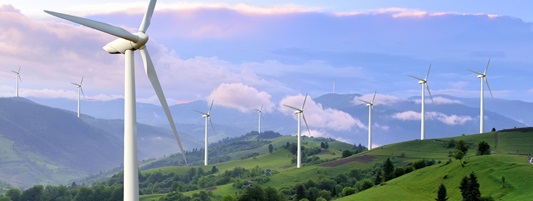Wind is used to produce electricity by converting the kinetic energy of air in motion into electricity. In modern wind turbines, wind rotates the rotor blades, which convert kinetic energy into rotational energy. This rotational energy is transferred by a shaft which to the generator, thereby producing electrical energy.
Wind power has grown rapidly since 2000, driven by R&D, supportive policies and falling costs. Global installed wind generation capacity – both onshore and offshore – has increased by a factor of 98 in the past two decades, jumping from 7.5 GW in 1997 to 1 131 GW by 2024 according to IRENA’s data. Wind energy added 113 GW of new capacity in 2024 alone, growing by 11.1% compared to the previous year. By 2024, onshore wind capacity had grown significantly since 2015, reaching 1 053 GW while offshore wind capacity reached 79.4 GW in 2024, representing a six-fold increase from 11.7 GW in 2015. Production of wind power has continued to increase substantially, reaching 2 304 TWh in 2023.
Both onshore and offshore wind still have tremendous potential for greater deployment and improvement, globally.
As the technology has improved and scaled up, costs have fallen and capacity factors have risen. Between 2010 and 2024, the global weighted-average levelised cost of electricity (LCOE) of onshore wind fell by 70%, from USD 0.089/kWh to USD 0.034/kWh. Over the same period, the LCOE of newly commissioned offshore wind projects fell by 62% from USD 0.208/kWh in 2010 to USD 0.079kWh in 2024.
Wind turbine capacity has increased over time. In 1985, typical turbines had a rated capacity of 0.05 MW and a rotor diameter of 15 metres. Today’s new wind power projects have a turbine capacity in the 3-4 MW range onshore and 8-12 MW offshore.
The amount of power that can be harvested from wind depends on the size of the turbine and the length of its blades. The output is proportional to the dimensions of the rotor and to the cube of the wind speed. Theoretically, when wind speed doubles, the wind power potential increases by a factor of eight.
Wind turbines first emerged more than a century ago. Following the invention of the electric generator in the 1830s, engineers started attempting to harness wind energy to produce electricity. Wind power generation took place in the United Kingdom and the United States in 1887 and 1888, but modern wind power is considered to have been first developed in Denmark, where horizontal-axis wind turbines were built in 1891 and a 22.8 metre wind turbine began operation in 1897. The modern wind power sector emerged in the 1980s.
Wind Energy Data
According to IRENA's latest data, the production of wind electricity in 2022 accounted for over 23% of the electricity generated by renewables. Many parts of the world have strong wind speeds, but the best locations for generating wind power are sometimes remote ones. Offshore wind power offers tremendous potential.










